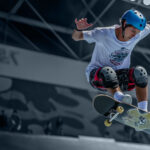Basketball and the NBA specifically is associated with extortionate costs related to and resulting from injury. Injury cost clubs in terms of players’ time lost, rehab and resources, with a 143 million dollar loss of wages due to injury reported in the NBA.
The costs can exponentiate considering the potential for games/titles lost whilst key players are sidelined with injury. Worryingly, almost 50% of NBA recruits for 2014 have sustained an injury, with several of the top draft picks sidelined for the entire season or seeing very little court time. The purpose of this post is to consider the sports-specific demands of basketball with a view to understanding the mechanisms underpinning the most common injuries accrued on the court.
Basketball is a high-intensity sport characterised by intermittent sprints, landing and cutting manoeuvres. As such, the lower limb is the most common site for injury. More specifically, the ankle and knee joints are susceptible to frequent and severe injury.
Ankle Injuries
Ankle injuries are the most frequent injury sustained by basketball players. An Australian basketball study determined that over half (53.7%) of the total time missed because of an injury in basketball was due to ankle pathology. Lateral ankle sprains are most common, resulting from hypersupination of the rear foot with plantar flexion that leads to strain or tearing of the lateral ankle ligaments. Thus peak torque during inversion and eversion are often included as assessment parameters during basketball talent identification procedures. Ankle injuries carry additional risk of becoming chronic, with high rates of recurring injury in both ankles. Further, the presence of an ankle injury can lead to an increase in back pain symptoms, crepitus and bilateral instability due to neuromuscular adaptations. Examinations of neuromuscular control parameters have found that an increased reaction time of the fibularis muscle (eccentric control) on landing, particularly on single leg landing, is associated with increased incidence of ankle sprain. Alterations in the neuromuscular control patterns result in decreased perception and changes in muscle reflex action in response to contact. If perceptual changes persist, feedback mechanisms result in adaptations at spinal cord level, thus resulting in an increased chance of sprain on the non-affected ankle in the future. Interestingly, and somewhat inexplicably, the incidence of ankle sprain across the career span of a basketball players appears to offer a protection against sustaining a knee injury. Specifically, ACL injury rate was lower for players who sustained an ankle injury.
Knee Injuries
Next to ankle injuries, knee injuries are most common amongst basketball players. Knee injuries most frequently take the form of meniscal tears or anterior cruciate ligament tears. Of the two, anterior cruciate ligament (ACL) tears are more severe in terms of time lost and rehab demands, often requiring reconstructive surgery and up to a year away from the court. ACL injury is the second most common incidence of lower limb injury reported by the NCAA. In the US non-conservative treatment of ACL injury costs $1 billion per year. ACL functions to stabilise the knee in dynamic movements. Risk factors for ACL injury are knee valgus, extension, sudden deceleration and change of direction. Thus ACL is a high risk injury in any sports, such as basketball, requiring speed and pivotal motion. Forces acting through the ACL are highest at 30 degrees of extension and hyperextension. ACL functions vary depending on degrees of knee flexion: Primarily it functions to restrain tibial anterior translation and provide rotary control in flexion and limiting tibial rotation. Secondarily it acts as a restraint for knee valgus.
Risk factors for ACL injury can be categorised in to anatomical, hormonal, biomechanical and environmental factors. Modifiable factors include core strength, proprioception, hamstring strength, neuromuscular recruitment and hormonal profile. Non-modifiable factors include anthropometric alignment, knee hyperextension, femoral notch size, inherited skills and coordination. Gender specific variations in ACL collagen fiber composition have been found in ACL deficient individuals. ACL injury can be acute or chronic, contact or non-contact. Most useful tests for diagnosing the presence of an ACL rupture are a positive result on the pivot-shift test or a negative result on the Lachmann anterior drawer test.
Combined analysis of two factors i.e. training hours in high risk sports and ligament laxity provide a predictive indication for the requirement for surgery. The University of Delaware management programs use predictive tests based in the dynamic knee stability and functional testing as opposed to the surgery risk factor prediction. This involves static stability risk factor measurement only whereby athletes are classified as copers or non-copers depending on the number of episodes of ‘giving-way’ in the knee post injury using a global rating of knee function that assesses activities of daily living and timed single-legged hop scores. Return to play is advised when there is an absence of pain/effusion, achievement of full ROM, negative pivotal shift scores and hamstring-quad strength of 85-100% compared to the non-injured limb. However, despite research investigating indications for both conservative and non-conservative treatments, the outcomes of rehab irrespective of treatment pathway remain similar and not overly positive for full return to pre-injury level. Thus attention is required to promote monitoring of ACL risk factors and focus on prevention rather than cure.
A contributing factor to the number of injuries sustained by basketball players over the course of a season is fatigue. Fatigue has been rated as the 2nd most important risk factor contributing towards non contact injury, with up to 80% of ACL injuries having been reported as occurring in non contact situations. Fatigue in basketball players is influenced by a series of factors including the volume of games played, the amount of travel involved in both the Professional and Collegiate game and the irregular sleep patterns experienced by elite level Basketball players. Irregular sleep patterns have been shown to reduce the amount of restorative sleep experienced by athletes which inhibits the removal of metabolites and other waste products from muscle and affects athlete recovery. This impaired recovery process has been shown to impact on the occurrence rates of both acute fatigue related injury and overuse fatigue related injury. Examinations on the effect of sleep duration on both performance and injury rates among elite level Basketball players revealed a reduction in injury rates and improvement in Basketball specific performance i.e sprint times, three point and free throw accuracy, in players with extended sleep durations. This highlights the role fatigue plays on both injury occurrence and performance among Basketball players and why the monitoring of player fatigue and sleep patterns should be incorporated into any strategy designed to prevent injury among athletes.
Conclusion
As outlined above, basketball is an intense sport that places high demands on joints and musculature of the lower limbs. It is advised that modifiable risk factors (fatigue, neuromuscular control, core-strength etc.) for general and joint-specific injuries are monitored carefully to ensure that the risk of players sustaining a debilitating injury are limited.
References
- Alentorn-Geli, E., Mendiguchía, J., Samuelsson, K., Musahl, V., Karlsson, J., Cugat, R., & Myer, G. D. (2014). Prevention of non-contact anterior cruciate ligament injuries in sports. Part II: systematic review of the effectiveness of prevention programmes in male athletes. Knee surgery, sports traumatology, arthroscopy, 22(1), 16-25.
- LaBella, C. R., Hennrikus, W., Hewett, T. E., Brenner, J. S., Brookes, M. A., Demorest, R. A., … & Wells, L. (2014). Anterior cruciate ligament injuries: diagnosis, treatment, and prevention. Pediatrics, 133(5), e1437-e1450.
- Myer, G. D., Ford, K. R., Khoury, J., Succop, P., & Hewett, T. E. (2010). Biomechanics laboratory-based prediction algorithm to identify female athletes with high knee loads that increase risk of ACL injury. British journal of sports medicine, bjsports69351.
- Mah, C. D., Mah, K. E., Kezirian, E. J. and Dement, W.C. (2011) The Effects of Sleep Extension on the Athletic Performance of Collegiate Basketball Players. Journal of Sleep, 943–950





